八年级仁爱英语Unit7_topic2学案
- 格式:doc
- 大小:98.50 KB
- 文档页数:10
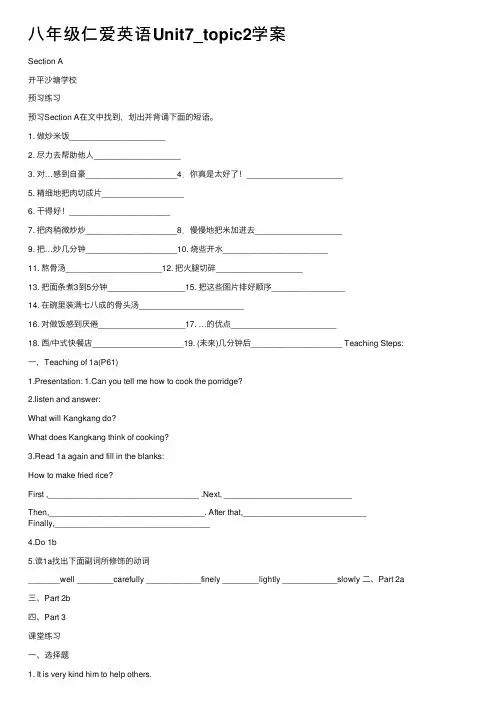
⼋年级仁爱英语Unit7_topic2学案Section A开平沙塘学校预习练习预习Section A在⽂中找到,划出并背诵下⾯的短语。
1. 做炒⽶饭_____________________2. 尽⼒去帮助他⼈___________________3. 对…感到⾃豪____________________4.你真是太好了!_____________________5. 精细地把⾁切成⽚__________________6. ⼲得好!______________________7. 把⾁稍微炒炒____________________8.慢慢地把⽶加进去___________________9. 把…炒⼏分钟____________________10. 烧些开⽔_______________________11. 熬⾻汤_____________________12. 把⽕腿切碎___________________13. 把⾯条煮3到5分钟_________________15. 把这些图⽚排好顺序________________14. 在碗⾥装满七⼋成的⾻头汤_______________________16. 对做饭感到厌倦___________________17. …的优点_______________________18. 西/中式快餐店____________________19. (未来)⼏分钟后____________________ Teaching Steps:⼀,Teaching of 1a(P61)1.Presentation: 1.Can you tell me how to cook the porridge?2.listen and answer:What will Kangkang do?What does Kangkang think of cooking?3.Read 1a again and fill in the blanks:How to make fried rice?First ,_________________________________ .Next, ____________________________Then,__________________________________. After that,___________________________ Finally,__________________________________4.Do 1b5.读1a找出下⾯副词所修饰的动词_______well ________carefully ____________finely ________lightly ____________slowly ⼆、Part 2a三、Part 2b四、Part 3课堂练习A. forB. toC. atD. of2. We’d better drink water when we are thirsty. It’s good for our health.A. boiledB. boilingC. cookedD. cooking3. Please put the pork into plate.A. otherB. another’sC. othersD. another4. One of the western fast food is you can eat it in a few minutes.A. disadvantagesB. advantageC. advantagesD. disadvantage5. A lot of people like eating out now because they’re cooking.A. pleased withB. tired ofC. interested inD. surprised at6. Then, the glass 60% full boiled water.A. put, intoB. fill, inC. fill, withD. add, to7. — What will you do first if you make dumplings?— First, I will cut up the meat .A. finelyB. fine8. The lake is more than 20 meters . So it must be dangerous to swim there.A. longB. wideC. deepD. deeply⼆、根据短⽂意思,排出正确的顺序。
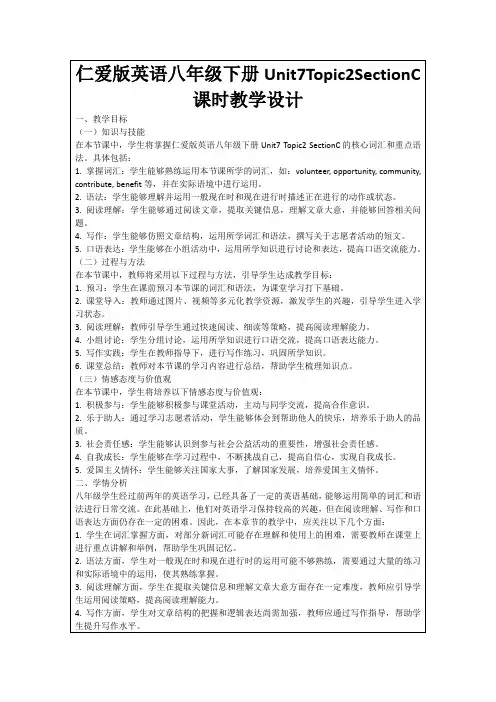
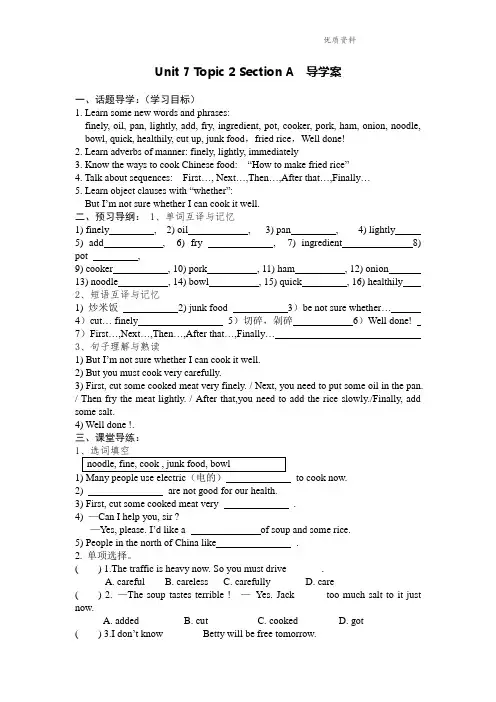
Unit 7 Topic 2 Section A 导学案一、话题导学:(学习目标)1. Learn some new words and phrases:finely, oil, pan, lightly, add, fry, ingredient, pot, cooker, pork, ham, onion, noodle, bowl, quick, healthily, cut up, junk food,fried rice,Well done!2. Learn adverbs of manner: finely, lightly, immediately3. Know the ways to cook Chinese food: “How to make fried rice”4. Talk about sequences: First…, Next…,Then…,After that…,Finally…5. Learn object clauses with “whether”:But I’m not sure whether I can cook it well.二、预习导纲:1、单词互译与记忆1) finely , 2) oil , 3) pan , 4) lightly5) add , 6) fry , 7) ingredient 8) pot ,9) cooker , 10) pork , 11) ham , 12) onion13) noodle , 14) bowl , 15) quick , 16) healthily2、短语互译与记忆1) 炒米饭2) junk food 3)be not sure whether…4)cut… finely 5)切碎,剁碎6)Well done! 7)First…,Next…,Then…,After that…,Finally…3、句子理解与熟读1) But I’m not sure whether I can cook it well.2) But you must cook very carefully.3) First, cut some cooked meat very finely. / Next, you need to put some oil in the pan. / Then fry the meat lightly. / After that,you need to add the rice slowly./Finally, add some salt.4) Well done !.三、课堂导练:1(电的)to cook now.2) are not good for our health.3) First, cut some cooked meat very .4) —Can I help you, sir ?—Yes, please. I’d like a of soup and some rice.5) People in the north of China like .2.单项选择。
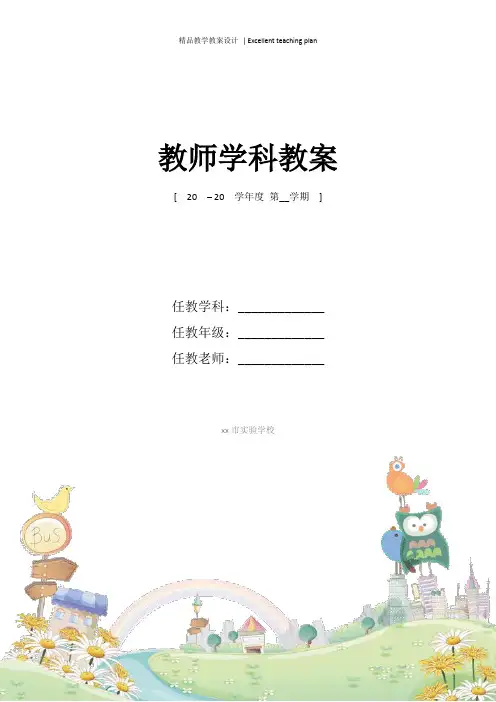
教师学科教案[ 20 – 20 学年度第__学期]任教学科:_____________任教年级:_____________任教老师:_____________xx市实验学校Unit 7 Topic 2 Section A【学习过程】一.独学(work alone)(1.) 词汇乐园( 单词复习检测)A: 切,剪,割______. 油_____. 添加_____ 炊具______ 猪肉_____ 便宜的______ 面条______- 碗盆_______ 立即_______优点_______ 便宜的______B finely_____ pan ____ fry ____ lightly _____ pot _____ onion______ (2)听读1a, 完成听力练习。
①What will Kangkang do? ______________________________②. What does Kangkang think of cooking? _____________________二.对学与群学(work in pairs /groups)(一)课文重点短语,句子集锦。
做炒米饭__________ 尽力做某事__________以…为自豪____________加入_____________ 需要做…__________ 把…放入___________熟肉_____________精细地切…_____________ 轻微地炒______________慢慢地加入米饭_________________加一些盐_______________首先______ 其次_______ 接下来_________ 然后_______ 之后_______ 最后__________我不确信我是否能做好__________________________________________________.我很高兴你在尽力帮助别人___________________________________.做得好___________你愿意我帮你吗___________________________?你是太好了_______________________. (二)听读课文,情景对话。
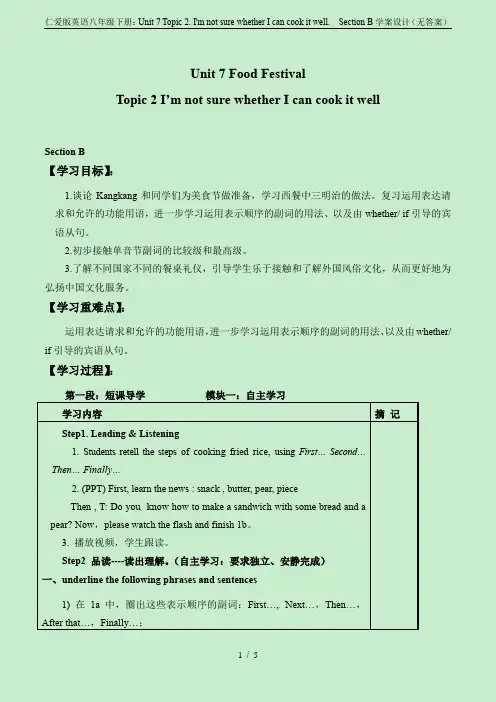
Unit 7 Food FestivalTopic 2 I’m not sure whether I can cook it wellSection B【学习目标】:1.谈论Kangkang和同学们为美食节做准备,学习西餐中三明治的做法。
复习运用表达请求和允许的功能用语,进一步学习运用表示顺序的副词的用法、以及由whether/ if引导的宾语从句。
2.初步接触单音节副词的比较级和最高级。
3.了解不同国家不同的餐桌礼仪,引导学生乐于接触和了解外国风俗文化,从而更好地为弘扬中国文化服务。
【学习重难点】:运用表达请求和允许的功能用语,进一步学习运用表示顺序的副词的用法、以及由whether/ if引导的宾语从句。
【学习过程】:第一段:短课导学模块一:自主学习学习内容摘记Step1. Leading & Listening1. Students retell the steps of cooking fried rice, using First… Second…Then… Finally…2. (PPT) First, learn the news : snack , butter, pear, pieceThen , T:Do you know how to make a sandwich with some bread and apear? Now,please watch the flash and finish 1b。
3. 播放视频,学生跟读。
Step2 品读----读出理解。
(自主学习:要求独立、安静完成)一、underline the following phrases and sentences1) 在1a 中,圈出这些表示顺序的副词:First…,Next…,Then…,After that…,Finally…;2) cut…into…把…切成…3) Would you mind if we learn to make it from you? 你介意我们跟你一起学做吗?4) Practice makes perfect. 孰能生巧嘛。

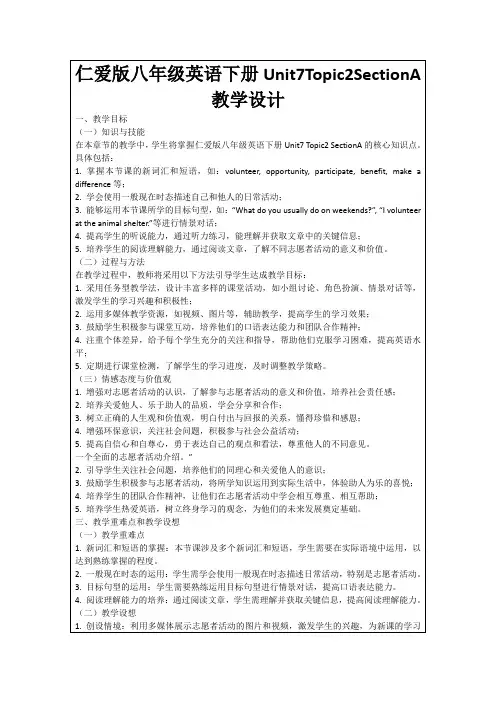
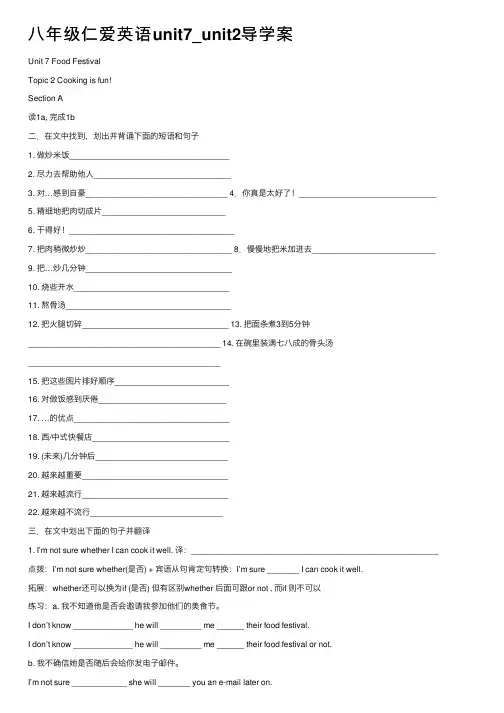
⼋年级仁爱英语unit7_unit2导学案Unit 7 Food FestivalTopic 2 Cooking is fun!Section A读1a, 完成1b⼆.在⽂中找到,划出并背诵下⾯的短语和句⼦1. 做炒⽶饭___________________________________2. 尽⼒去帮助他⼈______________________________3. 对…感到⾃豪_______________________________ 4.你真是太好了!______________________________5. 精细地把⾁切成⽚___________________________6. ⼲得好!____________________________________7. 把⾁稍微炒炒________________________________ 8.慢慢地把⽶加进去___________________________9. 把…炒⼏分钟________________________________10. 烧些开⽔__________________________________11. 熬⾻汤____________________________________12. 把⽕腿切碎________________________________ 13. 把⾯条煮3到5分钟__________________________________________ 14. 在碗⾥装满七⼋成的⾻头汤__________________________________________15. 把这些图⽚排好顺序_________________________16. 对做饭感到厌倦____________________________17. …的优点__________________________________18. 西/中式快餐店______________________________19. (未来)⼏分钟后_____________________________20. 越来越重要________________________________21. 越来越流⾏________________________________22. 越来越不流⾏_____________________________三.在⽂中划出下⾯的句⼦并翻译1. I’m not sure whether I can cook it well. 译:______________________________________________________点拨:I’m not sure whether(是否) + 宾语从句肯定句转换:I’m sure _______ I can cook it well.拓展:whether还可以换为if (是否) 但有区别whether 后⾯可跟or not , ⽽if 则不可以练习:a. 我不知道他是否会邀请我参加他们的美⾷节。
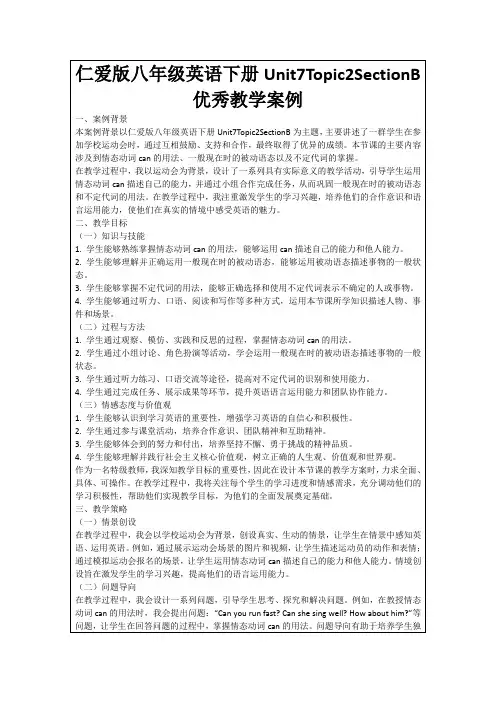
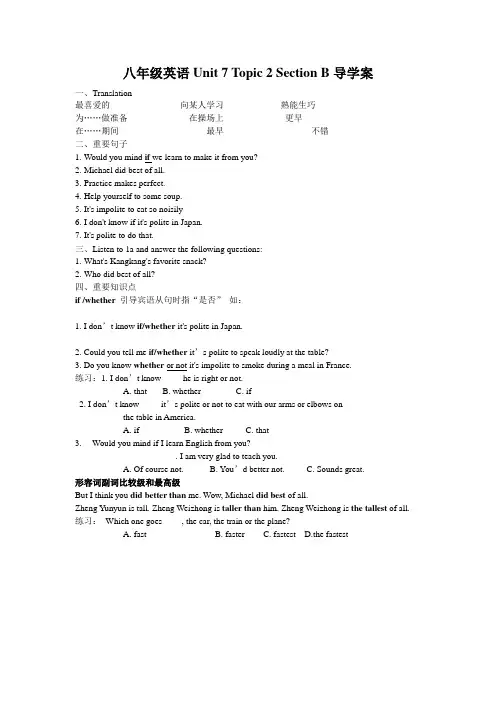
一、Translation最喜爱的向某人学习熟能生巧为……做准备在操场上更早在……期间最早不错二、重要句子1.Would you mind if we learn to make it from you?2.Michael did best of all.3.Practice makes perfect.4.Help yourself to some soup.5.It's impolite to eat so noisily6.I don't know if it's polite in Japan.7.It's polite to do that.三、Listen to 1a and answer the following questions:1.What's Kangkang's favorite snack?2.Who did best of all?四、重要知识点if /whether 引导宾语从句时指“是否”如:1. I don’t know if/whether it's polite in Japan.2. Could you tell me if/whether it’s polite to speak loudly at the table?3. Do you know whether or not it's impolite to smoke during a meal in France.练习:1. I don’t know ____ he is right or not.A. thatB. whetherC. if2. I don’t know ____ it’s polite or not to eat with our arms or elbows onthe table in America.A. ifB. whetherC. that3. ---Would you mind if I learn English from you?---__________. I am very glad to teach you.A. Of course not.B. Y ou’d better not.C. Sounds great.形容词副词比较级和最高级But I think you did better than me. Wow, Michael did best of all.Zheng Y unyun is tall. Zheng Weizhong is taller than him. Zheng Weizhong is the tallest of all. 练习:Which one goes ____, the car, the train or the plane?A. fastB. fasterC. fastestD.the fastest一、重点词汇第一次餐桌礼仪吃光为……干杯(祝福)举杯喝一小口记得要做某事记得不要做某事以……开始二、重点句子1.If you go to a formal western dinner party for the first time, you'd better know about western table manners.如果你第一次参加正式的西方宴会,最好了解一下西方的餐桌礼仪。
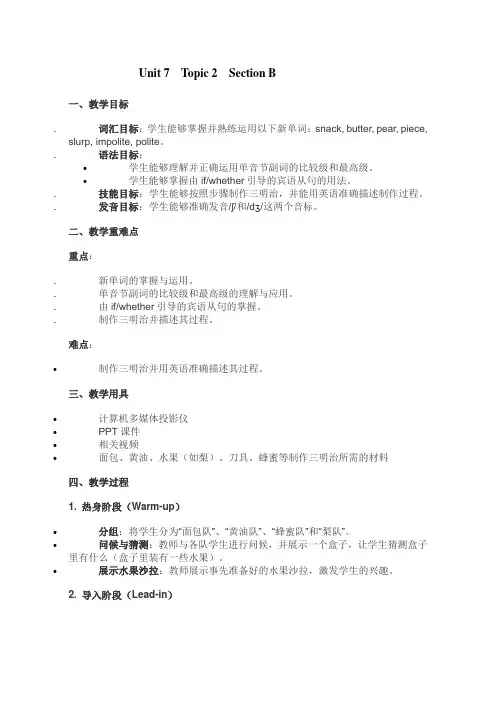
Unit 7 Topic 2 Section B一、教学目标. 词汇目标:学生能够掌握并熟练运用以下新单词:snack, butter, pear, piece, slurp, impolite, polite。
. 语法目标:•学生能够理解并正确运用单音节副词的比较级和最高级。
•学生能够掌握由if/whether引导的宾语从句的用法。
. 技能目标:学生能够按照步骤制作三明治,并能用英语准确描述制作过程。
. 发音目标:学生能够准确发音/ʃ/和/dʒ/这两个音标。
二、教学重难点重点:. 新单词的掌握与运用。
. 单音节副词的比较级和最高级的理解与应用。
. 由if/whether引导的宾语从句的掌握。
. 制作三明治并描述其过程。
难点:•制作三明治并用英语准确描述其过程。
三、教学用具•计算机多媒体投影仪•PPT课件•相关视频•面包、黄油、水果(如梨)、刀具、蜂蜜等制作三明治所需的材料四、教学过程1. 热身阶段(Warm-up)•分组:将学生分为“面包队”、“黄油队”、“蜂蜜队”和“梨队”。
•问候与猜测:教师与各队学生进行问候,并展示一个盒子,让学生猜测盒子里有什么(盒子里装有一些水果)。
•展示水果沙拉:教师展示事先准备好的水果沙拉,激发学生的兴趣。
2. 导入阶段(Lead-in)•情境导入:教师介绍一个喜欢零食的朋友Michael,并展示snack单词卡以及各种小吃图片。
询问学生Michael最喜欢的零食是什么,他是如何制作的。
然后播放音频,让学生听录音。
3. 呈现阶段(Presentation)•听力练习:播放1a的录音,让学生选择正确答案。
•新单词与短语学习:教授pear, butter, bread, a piece of, cut...into small pieces等新单词和短语。
•再次听力练习:再次播放录音,让学生完成1b的练习。
4. 练习与巩固阶段(Practice and Drills)•对话一:展示Kangkang与Michael的对话,让学生逐句跟读、复述,并根据关键词重新组织对话。
基于“课程标准、中招视野、两类结构”八英上Review of Unit7Topic2教案设计(复习课)张明一中李娟一.复习目标确定的依据:1. 课程标准相关要求:《英语课程标准》要求学生能在一定的语境中正确运用词汇知识、语法知识,语用知识等。
2.教材分析:本话题在复习上个话题的基础上,引入新的内容包括步骤的表达,描述方式的副词,做饭材料、做饭所用厨具以及吃饭所用餐具等词汇。
主要句型用提供帮助would you like me to help you?;赞美和鼓励Well done!重点语法内容:1.if和whether引导的宾语从句;2.副词的比较级和最高级以及it作形式主语的用法。
3.中招考点:词汇、短语的辨析,词性的分辨和转化常出现在单项选择题和词语运用题中,也是中考的考点;以及宾语从句和副词的比较级和最高级的考察。
4.学情分析:学生已学完了Units7Topic2,对主要知识点有所掌握,但是由于知识点较多,综合起来学生容易混淆。
特别短语的辨析及单词词性的转化较模糊。
对于这些问题应该师生共同探讨,分析,讨论并通过训练达到正确运用之目的。
二.复习目标1、能够正确说出P63—P70重点单词,词汇并能正确运用。
2、能熟练运用if和whether引导的宾语从句三.评价任务1.针对目标1,师生总结一些重点词汇、短语和句子,再通过训练,让学生能够正确运用P63—P70重点词汇、短语和句型。
2.针对目标2,总结Units7Topic1的重点语法,让学生能够掌握if/whether引导的宾语从句.四.教学过程复习目标教学活动评价要点要点归纳目标1: 能够正确复习指导 1复习内容:本单元P63—70的四会单词重点(一)词形转换:说出P63—P70重点词汇并能正确运用。
复习要求:听懂,会读,会说,会拼写,知道其汉语意思复习方法:看音标记单词,同桌互背复习时间:5分钟复习检测1:根据句意及首字母提示完成句子。
41. The tea is too strong. You need _________(add) some more water slowly.42. In parts of India, people use their _________(finger) to pick up the food.43. I think rice is grown in the _________ (south)part of China.44. It’s _________ (polite) to leave as soon asyou finish eating in China.45. It’s bad for your health if you always have_________ (quickly) breakfasts.一.通过复习巩固词汇及做习题、达到能掌握并灵活运用。
Unit7 Topic2 SectionA精品教案Ⅰ. Material analysis本节课为该话题的第一节课,建议用1课时上完。
主要活动为Section A 的1a和2a。
本话题围绕Kangkang和同学们为美食节做准备而展开。
在Section A中,由Kangkang跟妈妈学做炒饭引出炒饭和面条的制作过程和方法, 要求学生掌握表示顺序的副词的用法,养成做事有规律、讲顺序的好习惯;语法重点学习由whether/ if引导的宾语从句。
通过本课的学习鼓励学生在其原有的愿望和兴趣的基础之上,勇于实践、大胆尝试,培养学生的自主探究精神。
Ⅱ. Teaching aimsKnowledge aims:1. 学习whether/ if 引导的宾语从句。
2. 学习表示顺序的副词的用法。
Skill aims:1. 能听懂有关食物制作的话题的对话,识别主题,并获取主要信息。
1/ 242. 能使用英语陈述食物的制作过程。
3. 能理解所给语言材料中事件的发生顺序和人物行为。
4. 能写出简单的文段。
Emotional aims:在其原有的愿望和兴趣的基础之上,勇于实践、大胆尝试,具有自主的探究精神。
Ⅲ. The key points and difficult pointsKey points:1. 学习whether/ if 引导的宾语从句。
2. 学习表示顺序的副词的用法。
Difficult points:使用英语陈述食物的制作过程。
Ⅳ. Learning strategies注意发现语言的规律,如:副词的构词规则等,并能运用规律举一反三。
2/ 24Ⅴ. Teaching aidsComputer multimedia projector, the pictures of oil, the pan, the pot, the cooker, pork, ham, onions, noodles and the bowl.Ⅵ. Teaching procedures3/ 24Ⅶ. Blackboard design9/ 2410/ 24Unit7 Topic2 SectionA精品教案Ⅰ. Material analysis本节课为该话题的第一节课,建议用1课时上完。
Unit7 Topic2 SectionC参考教案Ⅰ. Material analysis本节课建议用1课时上完。
主要活动为Section C 的1a和2。
本课的阅读部分呈现的是谈论西餐的餐桌礼仪,来引出中西方饮食文化方面的差异,学习有关餐具的词汇,掌握有关就餐的短语,语法方面继续学习由whether和if 引导的宾语从句。
老师要让学生在对比中西餐桌不同礼仪的过程中,让学生互帮互学,开阔视野,既要促进新知的形成,又要激发学生探究学习、自主学习的热情。
在指导学生学习第二部分关于更多不同国家的餐桌礼仪时,要引导学生在了解中国风俗文化的同时,乐于接触和了解外国风俗文化,从而更好地为弘扬中国文化服务。
Ⅱ. Teaching aimsKnowledge aims:1. 继续学习whether/ if 引导的宾语从句。
2. 谈论西餐的餐桌礼仪。
3. 更多地了解不同国家的餐桌礼仪。
1/ 19Skill aims:1. 能听懂有关餐桌礼仪的短文,识别主题,并获取主要信息。
2. 能使用英语简述西餐的餐桌礼仪。
3. 能从所给语言材料中找出现关信息,理解大意。
4. 能写出简单的文段。
Emotional aims:1. 互帮互学,开阔视野。
2. 乐于接触和了解外国风俗文化,从而更好地为弘扬中国文化服务。
Ⅲ. The key points and difficult pointsKey points:1. 继续学习whether/ if 引导的宾语从句。
2. 谈论西餐的餐桌礼仪。
3. 了解不同国家的餐桌礼仪。
2/ 19Difficult points:演示西餐的餐桌礼仪。
Ⅳ. Learning strategies了解不同国家的餐桌礼仪有助于更好地进行跨文化交流。
Ⅴ. Teaching aidsComputer multimedia projector; The utensils mentioned in this section; Videos of a formal western dinner and a Chinese dinner.Ⅵ. Teaching proceduresIntroduction(8 minutes)1. Greet students ready for learning.2. Teacher lets the students retell the steps of making the sandwich, with First…Second…Then…Finally…3. Teacher asks the students to report the table manners in different countries they searched. Tell them3/ 19that they must follow the manners when they go to different countries.4. Teacher asks the students to read the sentences of 2. Teach the new words elbow, spoon and chopstick by showing the teacher’s elbow, a spoon and chopsticks.5. Teacher lets students discuss if these actions are polite.6. Teacher asks students to match the pictures with the conversation.7. Teacher lets students check the answers.8. Teacher divides the students into two groups. Let them practice the conversations. One group reads the questions and the other group reads the answers. Then let them change the roles. Finish 2. Presentation (10 minutes)1. Teacher asks the students to read 1a again, and then finish 1b. Teach the new word dine.2. Teacher asks two students to tell the answers.3. Teacher plays the recording sentence by sentence.4. Teacher plays the recording without stopping.4/ 195. Teacher lets the students read 1a, and then asks them to learn in groups to find out the difficult points. At last let them sum up the main points of the conversation.6. Teacher makes a summary to explain key points and difficult points to the students:(1) table manners(2) eat up(3) whether…or not …(4) drink to sb./sth.(5) take (only) a little(6) Remember not to …7. Teacher lets pairs of students prepare for the retelling with the help of the questions on the screen: What should you do when you sit down at the table?What does the dinner start with?What should you do when you start eating?5/ 19What should you do when you drink to somebody?Practice (10 minutes)1. Teacher asks the students to retell the passage in pairs. One student does some actions and the other describes in English.2. Teacher lets students evaluate the performances.3. Teacher lets students read 1a again and underline the key points about western table manners.4. Teacher plays a video about a Chinese dinner. Then let students work in groups and compare them with western table manners.5. Teacher lets two or three students report their results of comparing.6. Teacher asks two or three students to perform about the western table manners and the Chinese table manners.7. Teacher evaluates the performances and makes a summary.8. Teacher lets students read the example of 3.6/ 199. Teacher lets students understand the meanings of the sentences of 3. Teach the new word finger by pointing out the fingers of himself or herself.10. Teacher lets students discuss eating customs in different countries.11. Teacher lets students practice the conversations in pairs. Let them grasp the usage of object clauses. Production (7minutes)1. Teacher asks the students to prepare the game of describing: One student does an action of Part 2 or 3,a student from other groups describes the action in English. Ask the students to consolidate the usage of object clauses. The group which can describe correctly the most is the winner.2. Teacher lets students write a short passage about table manners in China, using object clauses and the information they have collected in 1c.3. Teacher lets two students write down the short passage on the blackboard.4. Teacher lets students discuss and evaluate the two students’written work, and then make a summary.5. Teacher shows the summary of this section to the students.7/ 196. Teacher assigns homework:(1) Review the summary after class.(2) Tell the western table manners to your parents.(3) Collect some eating habits in different countries.Teaching ReflectionThere are many differences between western table manners and Chinese table manners. Students are interested in trying showing the differences by themselves. And after the practicing of this section, they grasp the usage of object clauses very well.Ⅶ. Blackboard designUnit 7 Food FestivalTopic 2 I’m not sure whether I can cook it well.Section C1. table manners8/ 192. eat up3. whether…or not …4. drink to sb./sth.5. take (only) a little6. remember not to …Unit7 Topic2 SectionC参考教案Ⅰ. Material analysis本节课建议用1课时上完。
仁爱英语八年级上册Unit7Topic2SectionB教学案Unit7Topic2SectionB主备人:审阅人:使用人:一、目标要求1.掌握生词:butter,pear,piece,polite,poon,fork,choptick2.继续学习由“if/whether”引导的宾语从句:Canyoutellmeifit’politetoeatwithyourarmorelbowonthetableinA mericaDoyouknowwhethertheyuekniveIdon’tknowifthere’anyneedforknive,forkorchoptick.3.交际用语:(1)请求允许:Wouldyoumindifwelearntomakeitfromyou(2)吃饭:Helpyourelftoomeoup.二、教学方案1.复习SectionA:你能写出我们学习的表达动作顺序的词吗?你能举例说明我们上节学过的副词的构成和用法吗?2.自读1a.你能写出制作三明治的步骤吗?复述制作步骤。
Firt,Ne 某t,ThenAfterthat,Finally,3.你能写出对话中请求允许的句子并说说如何回答吗?4.再读1a两分钟,然后复述,同时完成1b。
5.你能找出对话中的副词比较级吗?解释副词比较级的用法并用副词比较级造句。
完成1c。
6.播放2a录音。
请同学们听录音,回答问题。
完成2a。
分角色表演2a。
7.不同的国家有不同的饮食习惯。
听2b录音,完成2b。
8.请同学们用红笔画出2b中的if/whether,探究if/whether引导的一般疑问句的宾语从句的用法;并对上一话题所学过的陈述句的宾语从句的用法进行归纳。
学习检测:一、词汇1.Youneedtwoofbread,ham,butterandapeartomakeaandwich.andknifetoeatintheweterncountrie.3.InCuba,it′toeatnoiily.It′abadmanner.4.Iwanttoknowifthere′noneedforwhenyoueatnoodle.acuplfteafor me!二、句型转换3.Wouldyoumindmokinghere(宾语改为否定形式)Wouldyoumindhere4.Kangkanggoetochoolat7:00.Michaelgoetochoo lat7:15.(作比较)KangkanggoetochoolMichael。
Unit 7 Topic2 Section AName Class一.独学(work alone)(1.) 词汇乐园( 单词复习检测)A: 切,剪,割______ 油_____ 添加_____ 炊具______ 猪肉_____面条_________ 立即_______ 优点_______ 便宜的______B finely_____ pan ____ fry ____ lightly _____ pot _____ onion______(2)听读1a, 完成听力练习。
①What will Kangkang do?__________________________________________________②What does Kangkang think of cooking? _______________________________________二.对学与群学(work in pairs /groups)(一)课文重点短语,句子集锦。
1.做炒米饭_____________________2.尽力做某事_______________3. 以…为自豪____________4.加入____________5.需要做…____________6.把…放入_____________7.熟肉_____________8.精细地切…_____________ 9.轻微地炒_____________10.慢慢地加入米饭_________________11.加一些盐_______________12. 首先___________ 13.其次_________14. 接下来____________15.然后___________16. 之后________________17. 最后_________________18.我不确信我是否能做好。
________________________________________________ __.19.我很高兴你在尽力帮助别人。
Section A开平沙塘学校预习练习预习Section A在文中找到,划出并背诵下面的短语。
1. 做炒米饭_____________________2. 尽力去帮助他人___________________3. 对…感到自豪____________________4.你真是太好了!_____________________5. 精细地把肉切成片__________________6. 干得好!______________________7. 把肉稍微炒炒____________________8.慢慢地把米加进去___________________9. 把…炒几分钟____________________10. 烧些开水_______________________11. 熬骨汤_____________________12. 把火腿切碎___________________13. 把面条煮3到5分钟_________________15. 把这些图片排好顺序________________14. 在碗里装满七八成的骨头汤_______________________16. 对做饭感到厌倦___________________17. …的优点_______________________18. 西/中式快餐店____________________19. (未来)几分钟后____________________ Teaching Steps:一,Teaching of 1a(P61)1.Presentation: 1.Can you tell me how to cook the porridge?2.listen and answer:What will Kangkang do?What does Kangkang think of cooking?3.Read 1a again and fill in the blanks:How to make fried rice?First ,_________________________________ .Next, ____________________________Then,__________________________________. After that,___________________________ Finally,__________________________________4.Do 1b5.读1a找出下面副词所修饰的动词_______well ________carefully ____________finely ________lightly ____________slowly 二、Part 2a三、Part 2b四、Part 3课堂练习一、选择题1. It is very kind him to help others.A. forB. toC. atD. of2. We’d better drink water when we are thirsty. It’s good for our health.A. boiledB. boilingC. cookedD. cooking3. Please put the pork into plate.A. otherB. another’sC. othersD. another4. One of the western fast food is you can eat it in a few minutes.A. disadvantagesB. advantageC. advantagesD. disadvantage5. A lot of people like eating out now because they’re cooking.A. pleased withB. tired ofC. interested inD. surprised at6. Then, the glass 60% full boiled water.A. put, intoB. fill, inC. fill, withD. add, to7. — What will you do first if you make dumplings?— First, I will cut up the meat .A. finelyB. fineC. finallyD. good8. The lake is more than 20 meters . So it must be dangerous to swim there.A. longB. wideC. deepD. deeply二、根据短文意思,排出正确的顺序。
Do you know how to cook meat? Let me tell you how to do it. Please listen to me carefully. (a) Then, fry the meat for a few minutes. (b) Next, put some oil and sugar in the pan. (c) First, buy some fresh meat. (d) Finally, and some salt. (e) Second, cut the meat finely.Do you want to have a try?正确的顺序:1. 2. 3. 4. 5.Section B预习练习预习Section B在文中找到,划出并背诵下面的短语1.你最喜欢的小吃是什么?2.把梨切成小片。
3.把两片面包合在一起。
4.熟能生巧5.随便喝点汤6.它表明你非常喜欢这食物课前检测:( )1. Cook noodles for 3-5 minutes in ___ pot.A. otherB. anotherC. othersD. the other( )2. ______ is good for our health.A. RunB. RunningC. RunsD. To run( )3. We are proud ______ our school.A. ofB. forC. inD. to( )4. It’s very kind _____ you to help us.A. forB. toC. atD. of( )5. Linda does her homework ______.A. careB. carefulC. carefullyD. cares( )6. –-We win the match ! ---______.A. Never mind.B. It doesn’t matter.C. You’re welcome.D. Well done!二、用所给动词的适当形式填空:1.Would you like me ______ (help) you?2.I’m glad that you are trying ______ (help) others.3.Cut some cooked meat _________(fine).4.Put a large deep pot on the _______ (cook) carefully.5.What do I need ________(do)?6.You need to add the rice ______ (slow).7._______(final) you should add some salt.Teaching Steps一、Review: Can you tell me how to make fried rice?二.Teaching of 1a 1. Listen and answer:(1) What’s Michael’s favorite snack?(2) Who did best of all?2.Read 1a again and retell the process of making a sandwich, using “first,next, then---“3.do 1c三、Teaching of 2a Listen and answer:1.How is the soup?2..Is it impolite to eat so noisily?四、do 2b课堂练习:( ) 1. I don’t know ____ he is right or not.A. thatB. whetherC. if( ) 2. Which one goes ____, the car, the train or the plane?A. fastB. fasterC. fastest( ) 3. It’s very kind ____ you to help me with my English.A. forB. withC. of( ) 4. Please ____ the ham and green onions finely, then add them to the bread.A. cut upB. cut intoC. cut in( ) 5. I don’t know ____ it’s polite or not to eat with our arms or elbows on the table in America.A. ifB. whetherC. that( ) 6. ---Would you mind if I learn English from you?---__________. I am very glad to teach you.A. Of course not.B. You’d better not.C. Sounds great.课后练习:I.根据首字母提示填空1. You need two p of bread, ham, butter and a pear to make a sandwich.2. We use c to eat. While people use a f and knife to eat in the western countries.3. In Cuba, it’s i to eat noisily. It’s a bad manner.4. I want to know if there’s no need for s when you eat noodles.5. P a cup of tea for me!Ⅱ.句型转换1. Could you tell me? Will you come tomorrow?(合并成一句)Could you tell me come tomorrow.2. I want to know. Is it polite to smoke during a meal in France?(合并成一句)I want to know polite to smoke during a meal in France.3. Would you mind smoking here?(宾语改为否定形式)Would you mind here?4. Kangkang goes to school at 7:00. Michael goes to school at 7:15.(作比较)Kangkang goes to school Michael.Section C预习练习预习SectionC 在文中找到,划出并背诵下面的短语1. 第一次____________________2. 了解___________________3. 西方的餐桌礼仪_____________________4. 在桌旁______________________5. 以…开始____________________6. 吃光,吃完__________________7. 大声的说话____________________ 8. 为某人/某事干杯____________________9. 喝一小口______________________ 10.记得不要喝太多___________________11.跟着别人做_______________________12. 就餐_____________________14. 在右边________________________15. 用汤匙喝汤,吃甜点______________________16.用筷子指人________________________17. 用左手吃__________________________________18. 完成做某事________________________________19. 吃中餐_____________________________堂前练习:选择题1. I would like a sandwich honey.A. ofB. inC. forD. with2. — Would you mind if I learn to make beef noodles you?— Of course .A. from, don’tB. from, notC. for, don’tD. for, not3. Could you tell me it is true or not?A. ifB. whetherC. thatD. what4. I t’s polite up your hand before answering the questions.A. putB. puttingC. putsD. to put5. Do you know smoke during a meal in China?A. if is it polite toB. if it is polite toC. whether is it polite toD. whether it is polite6. In Japan, it’s polite to eat soup and finish all the rice.A. noisilyB. noiseC. noisyD. noises7. We’re not sure we will go out tomorrow. We will go swimming it is sunny.A. if, whetherB. if, thatC. whether, ifD. what, if8. After that, pour some honey the pear, , put them together.A. on, FinalB. over, FinallyC. above, FinallyD. with, Final9. — How do you like the soup?— (Slurp!) I like it very much.A. Not goodB. Not wellC. Not badD. Very bad10. — Do you think Michael works than Kangkang and Jane?— Yes, I think so. He works of the three.A. hard, harderB. harder, hardestC. hardest, hardD. hardest, harderTeaching steps一、Review :二、Presentation: Teaching of 1a(P65) the things in the picture.2.Listen and answer:(1).Is it polite to eat up everything on your plate?(2).Is it polite to take more food than you need?(3).Is it polite to speak loudly at the table?(4).Is it polite to drink too much during the dinner?3.do 1b4.Answer the questions according to 1a. Then retell the passage. (1).What should you do when you sit down at the table?(2).What does the dinner start with?(3).How should you keep the fork and knife when you start eating?(4).Why can’t you take more food than you need?(5).Can you speak loudly at the table?(6).What should you do when you drink to somebody?(7).Can you drink too much during the dinner?三、do part 2四、part 3课堂练习把下列句子合并成一个含有宾语从句的复合句。